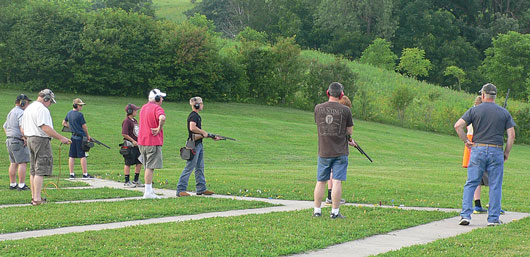Clay Shooting

With roots that sink deep into the hunting traditions of wing shooting, the clay shooting sports are perhaps some of the oldest formal competitive shooting styles still in common practice with modern firearms. In fact, the earliest forms of these games involved live birds, which is where terms like “clay pigeon”, “trap,” and “PULL!” came from. Clay shooting is a shotgun sport in which shooters engage flying frangible targets in an effort to break them before they touch the ground. The standard regulation size clay pigeon resembles a frisbee that is 110x28.5mm in size, generally orange in color, and made of a very brittle ceramic material. When struck by shot pellets, these targets shatter into pieces which constitutes a scoring hit. While always intended to mimic the flight of game birds, there are a variety of ways to present the targets to shooters which has primarily evolved into three games: Trap, Skeet, and Sporting Clays.
Trap
Trap is generally considered the easiest of the shotgun games to learn, is the least intimidating to the novice shooter, and is the most prevalent across the country. The targets are launched from a bunker that is a minimum of 16 yards distant and thrown straight away at generally random angles between 10:00 and 2:00 relative to the shooter. A “round” of Trap consists of five shots from five positions for a grand total of 25 target presentations. The level of difficulty can be increased by increasing the distance from the target thrower, varying the target size, throwing pairs of targets, or using smaller gauge shotguns.
Trap specific guns generally vary from field shotguns by having less emphasis on lateral swing characteristics, longer barrels of 30+ inches, tighter chokes, and are generally “zeroed” to have a higher point of impact than the run of the mill field gun. This is because, in Trap, target presentations are always long distance, straight away, and constantly rising. Dedicated trap guns are also built heavier duty than field guns because they are carried less and see much higher volumes of rounds fired than the typical field gun. With that said, vast majority of trap shooters are hunters practicing for the season, so at the club level field guns are extremely common.
Skeet
While Trap is considered the easiest game to learn, Skeet is often hailed as the easiest to master. Skeet involves targets thrown from two traps. One is ten feet above the ground (aka the “high house”) and the other from three feet (aka the “low house”) in opposite directions. Both traps throw the targets through a common intersecting point. A round of skeet involves shooting a target from each house from each of seven positions in a semi-circle configuration. In addition, four of the positions also require the shooting of a double which is one target thrown from each house simultaneously. An eighth position is also directly between the two houses and requires a shot from each. Skeet shots are generally fast and crossing, so the shooter must master swinging the gun and proper leading of the targets. While this differs from trap, skeet target presentations are exactly the same every time, so the specifics of each shot from each station are easy to anticipate and master.
When compared to Trap guns, Skeet guns resemble field shotguns much more closely. This is because, like hunting, Skeet places an emphasis on lateral swinging of the shotgun. Therefore the barrels tend to be 26-30” in length and use open choke constrictions (because the targets are very close). Purpose built skeet guns also tend to have heavier duty actions and mechanisms than field grade guns because they are carried less and shot vastly more. Use of field grade guns, however, is extremely common.
Sporting Clays
While Trap and Skeet are extremely standardized and dimensionally defined in terms of course layout and target presentation, Sporting Clays is exactly the opposite. Best described as “golf with a shotgun,” course designers can literally present targets in any fashion they see fit in an effort to truly replicate hunting scenarios. Targets can come from all angles, at any distance, in all sizes, and at any speed. Courses can also present targets as singles, report pairs (second target thrown when shooter shoots the first), or true pairs (two targets thrown simultaneously). There are variants of sporting clays that take place on a Trap/Skeet sized field, but usually Sporting Clays courses are in fact courses with stations spread out over natural terrain in golf course-like fashion.
Since the true nature of Sporting Clays is to replicate hunting target presentations, Sporting Clays guns often closely resemble hunting shotguns. Generally barrel lengths are 28-30” to have smooth swinging characteristics. Purpose built Sporting Clays guns will have heavier duty actions to withstand higher volumes of use than typical field grade shotguns. Field grade shotgun use in Sporting Clays is also extremely common.
Clay Shooting Gear
Aside from the guns themselves, the gear required to shoot clays is very minimal. Eye and ear protection is always required. A means of carrying shells is also helpful. Many shooters choose to use purpose built vests with pockets for their shells. These have the benefit of supplemental shoulder padding from recoil. Another popular option is a belt mounted pouch that holds a box or two of shells.



